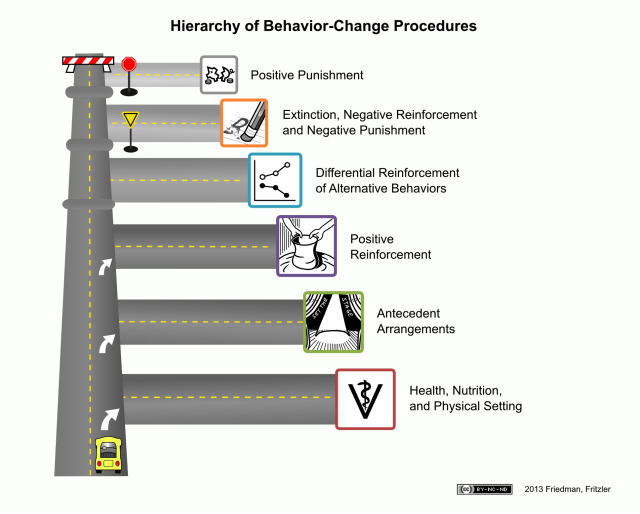The Humane Hierarchy is a model in which training methods are ranked from leash invasive to most invasive. Dr. Susan Friedman, a well-respected and knowledgeable behavior analyst, coined this term and model. This model has been adapted by the Certification Council of Professional Dog Trainers as the guide for their trainers to use when working with dogs.
The model is broken down into 6 levels. Trainers should thoroughly explore the options at every level before escalating their training method to more intrusive choices.

Image via Behavior Works
Health, Nutrition, and Physical Setting
Health and nutrition affect a dog’s body chemistry and, thus, its behavior. Failing to address the dog’s medical issues will likely reduce the effectiveness of any training. For example, consider a dog that is acting aggressively when a child pets the dog on the head. If the dog is experiencing pain due to an ear infection, the dog is only reacting due to the pain the petting causes the dog. Behavior modification will be ineffective to change this dog’s reaction. A professional dog trainer should understand some key signals that pain or medical issues could be the route of a problem so they can refer to a veterinarian when appropriate. Many trainers choose to have clients take their dogs to the vet for a wellness exam before any training begins.
Antecedent Arrangement
Much problematic behavior is a response to an environmental trigger. A dog’s behavior is influenced by the environment. Manipulating the environment so that the dog does not experience the trigger can eliminate the entire problem. Without thoroughly completing this step before moving on with more intrusive training, the antecedent to the dog’s behavior may continue to trigger the same response. For example, if a dog barks when he sees other dogs through a window, applying a frosted window film at the dog’s eye level will eliminate the problem without further intervention. Without this step, training will not progress as smoothly as it could.
Positive Reinforcement
Once a dog’s health has been examined and the antecedents to the behavior have been eliminated or changed, positive reinforcement is the least intrusive way to modify behavior. Positive reinforcement is the addition of something the dog desires in order to increase the frequency of the behavior in the future. Ultimately, dogs repeat behaviors that create desirable consequences. Setting up the environment to help the dog make the right choices and then using positive reinforcement to reward those choices is the most humane behavior modification method if it can be applied safely.
Differential Reinforcement of Alternative Behaviors
Differential reinforcement involves strongly reinforcing certain alternative behaviors to the problem behavior. It also includes removing the reinforcer for the problem behavior.
Negative Reinforcement, Negative Punishment, & Extinction
Notice the yield sign before this option in the chart. These behavior modification methods can increase stress and anxiety in the dog. The emotional ramifications on a dog should be considered before utilizing these. Much of the stress can come from the dog’s lack of understanding of what it is supposed to do instead of the problem behavior. Once the problem behavior stops producing the dog’s expected consequence, the dog can experience frustration and anxiety. The dog may not have a clear understanding of what will work instead.
Positive Punishment
The stop sign before this option in the chart reflects the fact that this is a last resort. The CCPDT suggests that trainers consult with one another to find alternative solutions to positive punishment. Positive punishment is the addition of something the dog deems undesirable and works to avoid in order to decrease the frequency of the problem behavior in the future. Most likely, all the other options have not been exhausted if a trainer chooses to use positive punishment as a means to train a dog. Environmental management, health, and less invasive techniques should be thoroughly implemented before utilizing positive punishment. Lack of creativity and problem solving skills can often lead trainers to use this method too soon.
Do you consider yourself a Humane Hierarchy modern dog trainer?




Funny typo in the first sentence